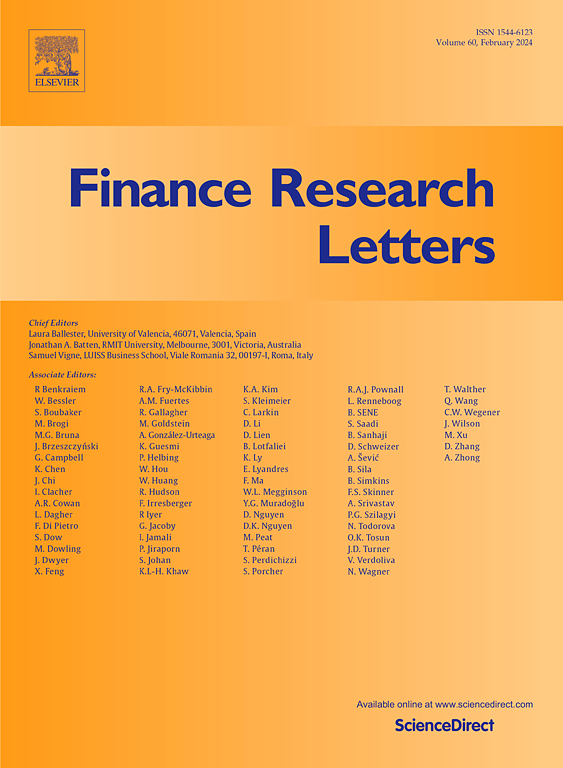中国与“一带一路”沿线国家农业部门通胀溢出效应及其形成机制
IF 6.9
2区 经济学
Q1 BUSINESS, FINANCE
引用次数: 0
摘要
本文采用动态网络方法和时变溢出指数模型对中国与“一带一路”沿线国家农业部门的通胀溢出效应进行了定量评估。研究结果表明,“一带一路”沿线国家农业通胀总体上存在很强的关联性,2011 - 2013年总溢出指数呈现快速上升后逐渐下降的趋势。值得注意的是,2012年6月,中国从通胀溢出效应的净接受国转变为净贡献国。中国的净溢出效应在东南亚似乎更为明显,而中国与中欧和东欧国家的互动则呈现出一种强弱交替的模式。机制检验表明,国际贸易、资本流动和市场情绪与中国与“一带一路”沿线国家农产品通胀溢出效应密切相关。异质性分析表明,对于海上丝绸之路沿线国家和发达国家,溢出效应主要通过贸易和资本流动渠道发生,而对于陆上丝绸之路沿线国家和发展中国家,情感因素的作用更为显著。此外,浮动汇率制度和健全的制度质量可以在一定程度上防范通胀。最后,中国在高质量农业发展方面取得的进展与外部溢出水平的降低有关。本文章由计算机程序翻译,如有差异,请以英文原文为准。
Inflation spillover effect of agricultural sector and its formation mechanism between China and the countries along the Belt and Road
This paper employs a dynamic network approach and a time-varying spillover index model to quantitatively assess the inflation spillover effects within the agricultural sectors between China and the Belt and Road Initiative (BRI) countries. Our findings reveal that there is a strong overall interconnectedness in the agricultural inflation among BRI countries, with the total spillover index exhibiting a rapid increase from 2011 to 2013, followed by a gradual decline. Notably, China transitioned from being a net recipient to a net contributor of inflation spillovers in June 2012. The net spillover influence of China appears to be more pronounced in Southeast Asia, while its interactions with Central and Eastern European countries exhibit a pattern of alternating strength. Mechanism tests suggests that international trade, capital flows, and market sentiment are closely associated with agricultural inflation spillovers between China and BRI countries. Heterogeneity analysis indicates that for countries along the Maritime Silk Road and developed nations, spillovers predominantly occur through trade and capital flow channels, whereas sentiment factors play a more significant role in countries along the Land Silk Road and developing nations. Moreover, a floating exchange rate regime and robust institutional quality can provide some insulation against inflation. Finally, China’s progress in high-quality agricultural development is associated with a reduced level of outward spillovers.
求助全文
通过发布文献求助,成功后即可免费获取论文全文。
去求助
来源期刊

Finance Research Letters
BUSINESS, FINANCE-
CiteScore
11.10
自引率
14.40%
发文量
863
期刊介绍:
Finance Research Letters welcomes submissions across all areas of finance, aiming for rapid publication of significant new findings. The journal particularly encourages papers that provide insight into the replicability of established results, examine the cross-national applicability of previous findings, challenge existing methodologies, or demonstrate methodological contingencies.
Papers are invited in the following areas:
Actuarial studies
Alternative investments
Asset Pricing
Bankruptcy and liquidation
Banks and other Depository Institutions
Behavioral and experimental finance
Bibliometric and Scientometric studies of finance
Capital budgeting and corporate investment
Capital markets and accounting
Capital structure and payout policy
Commodities
Contagion, crises and interdependence
Corporate governance
Credit and fixed income markets and instruments
Derivatives
Emerging markets
Energy Finance and Energy Markets
Financial Econometrics
Financial History
Financial intermediation and money markets
Financial markets and marketplaces
Financial Mathematics and Econophysics
Financial Regulation and Law
Forecasting
Frontier market studies
International Finance
Market efficiency, event studies
Mergers, acquisitions and the market for corporate control
Micro Finance Institutions
Microstructure
Non-bank Financial Institutions
Personal Finance
Portfolio choice and investing
Real estate finance and investing
Risk
SME, Family and Entrepreneurial Finance
 求助内容:
求助内容: 应助结果提醒方式:
应助结果提醒方式:


